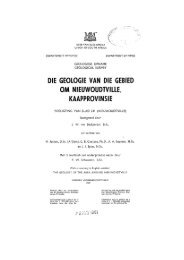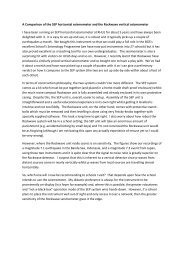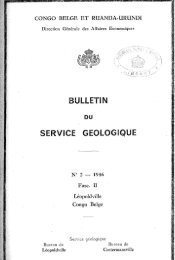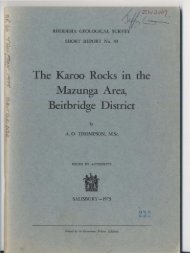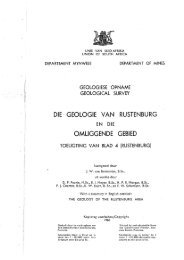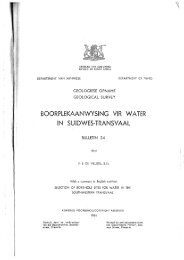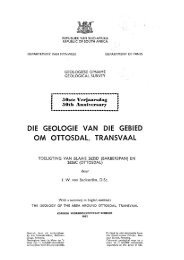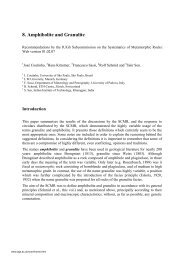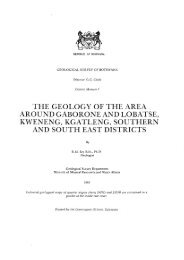Bibliography - British Geological Survey
Bibliography - British Geological Survey
Bibliography - British Geological Survey
Create successful ePaper yourself
Turn your PDF publications into a flip-book with our unique Google optimized e-Paper software.
Sollas, W. J. 1911. Ancient hunters and their modern representatives. London: Macmillan and Co., xvi,<br />
416 pp. (The opening paragraph of Chapter II: The Antiquity of Man, p. 29, neatly summarises the state of<br />
knowledge in late 1911 concerning man’s origins. The book appeared just a few months before Charles<br />
Dawson informed Smith Woodward of his discovery at Piltdown. Sollas writes: ‘The dawn of the human<br />
race is supposed to belong to a past more remote than the beginning of the Great Ice age; yet of the existence<br />
of man antecedent to that epoch not a vestige of evidence, forcible enough to compel universal belief, has up<br />
to the present time been discovered. Even Pithecanthropus, that singular ape-like form, which makes the<br />
nearest approach to the genus Homo, although referred by its discoverer to the Pliocene, has since been<br />
asserted on good authority to belong more probably to the Quaternary epoch.’)<br />
Sollas, W. J. 1913 (contribution to discussion in Dawson & Woodward 1913b)<br />
Sollas, W. J. 1915. Ancient hunters and their modern representatives. 2nd ed. London: Macmillan.<br />
(Piltdown, pp 49–56)<br />
Sollas, W. J. 1924. Ancient hunters and their modern representatives. 3rd ed. London: Macmillan. (In this<br />
edition Sollas included, for the first time, a note dismissing the Sherborne engraved bone as ‘a forgery<br />
perpetrated by some schoolboys’, p. 536 n. Smith Woodward had described it as an authentic Palaeolithic<br />
artefact in 1914. See Woodward 1914b, and Woodward 1926 for his response to Sollas’s assertion.)<br />
Sollas, W. J. 1926. The Palaeolithic drawing of a horse from Sherborne. Nature, 117, 233. (A response to<br />
Woodward 1926)<br />
Somerville, E. M. 1996. Piltdown reflections: a mirror for prehistory. Sussex Archaeological Collections,<br />
134, 7–19. (An examination of the history of the Society’s relationship with the Piltdown discoveries)<br />
Sommer, M. 2004. Eoliths as evidence for human origins? The <strong>British</strong> context. History and Philosophy of<br />
Life Science, 26, 209–241.<br />
Spaulding, A. C. 1955. Further contributions to the solution of the Piltdown problem. American Journal of<br />
Physical Anthropology, 13, 166–167. (A commentary on Weiner et al. 1955)<br />
Spencer, F. 1979. Aleš Hrdlička MD (1869‒1943): a chronicle of the life and work of an American physical<br />
anthropologist. London: University Microfilms International, 2 vols.<br />
Spencer, F. 1984. The Neandertals and their evolutionary significance: a brief historical survey. In: The<br />
origins of modern humans: a world survey of the fossil evidence / edited by F. H. Smith & F. Spencer. New<br />
York: Alan R. Liss, pp. 1–49. (Turritin cites pp. 21–34)<br />
Spencer, F. 1987. Ape jape: The Piltdown Inquest, by Charles Blinderman. New Scientist, 113 (5 Mar),<br />
50–51. (An uncharitable review from one who at this time was preparing his own rival account of the Piltdown<br />
forgery. A few months later Blinderman offered to return the compliment by reviewing Spencer’s<br />
forthcoming book: see ‘Piltdown rivals’, New Scientist, 114, 7 May 1987, 67.)<br />
Spencer, F. 1988. Prologue to a scientific forgery: the <strong>British</strong> eolithic movement from Abbeville to<br />
Piltdown. In: Bones, bodies, behaviour: essays on biological anthropology / edited by G. W. Stocking.<br />
Madison: University of Wisconsin Press, pp. 84–116.<br />
Spencer, F. 1990a. Piltdown: a scientific forgery. London, Oxford & New York: Natural History Museum<br />
Publications / Oxford University Press, xxvi, 272 pp. (A considerable amount of scholarly research is here<br />
weakened only by the final chapter in which the writer attempts to implicate Sir Arthur Keith as the forger<br />
following a line of enquiry developed by Ian Langham, whose papers, after his death in 1984, were passed<br />
to Frank Spencer because he had independently come to the same conclusion. Includes an introduction by<br />
Phillip V. Tobias. A number of lengthy reviews appeared: see Campbell 1991, Fagan 1991, G. A. Harrison<br />
1990, J. Marks 1992, Shipman 1990, Zuckerman 1990b; for other rebuttals see Costello 1990b, Grigson<br />
1990b, 1991, L. J. Keith 1990, Kennedy 1991, Langdon 1992a, A. Miles 1991, & Zuckerman 1990a.<br />
Turrittin 2006, 22–24, lists many more.)<br />
Spencer, F. (ed.) 1990b. The Piltdown papers: the correspondence and other documents relating to the<br />
Piltdown forgery, 1908–1955. London, Oxford & New York: Natural History Museum Publications / Oxford<br />
University Press, xii, 282 pp. (An essential reference tool for the Piltdown researcher, though now in need<br />
of expansion and revision, since not all of the relevant correspondence held at the NHM was included.)



